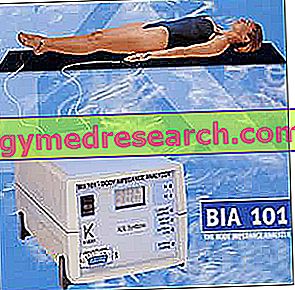By Dr. Simone Losi
The first step in order to organize a truly personalized training card, and appropriate nutrition, is the objective knowledge of body composition.
The plicometry, which is based on the use of a plicometer through which the subject's percentage of fat mass is extrapolated, presents a very significant limit: it assumes that the subject is well hydrated, ie that he has a percentage of total body water of the 60%. Otherwise all the values that come out of the exam are not reliable!
This means, in practice, that if we do not know the client's hydration condition beforehand, we risk making gross errors of assessment because, if by chance the subject was dehydrated (but we do not know), all the values of the plicometry would be unreliable.
To know the hydration status of the person it is necessary to use a tool that "measures" the body water. Among the various possibilities, the BIA is certainly the easiest to use and least invasive method for the personal trainer.
In just a few minutes, this tool gives the technician the opportunity to know, in addition to the state of hydration, a series of fundamental values to be able to then propose a correct training and an appropriate diet, both from a qualitative and quantitative point of view .

As you can see from the figure on the side, the subject is made to lie down and the resistance and reactance of his body is measured by placing 4 electrodes, two on the hand and two on the foot.
These two values will then be included in the supplied software, thanks to which a series of data will be extrapolated which I will now explain in detail.
BCM : (CELL MASS): it is the metabolically active component of the body.
Each person has a minimum BCM under which it is not recommended to go down, due to a decrease in both lean muscle mass and metabolism.
It is the fundamental value that needs to be monitored over time, and that allows us to understand if the person is malnourished and overtraining.
TBW : (TOTAL BODY WATER): it is the major component of the organism, so the correct determination forms the basis for estimating the physical fitness parameters. If the water is normal all the parameters measured by the BIA will be reliable, so consequently the plicometry will be correct.
BCMI : (BODY CELL MASS INDEX): is the relationship between the BCM and the HEIGHT of the subject. Indicates the nutritional status of the subject.
Values lower than 8 for women and 10 for men indicate Malnutrition.
PA : (PHASE ANGLE): measures the relationship between resistance and reactance.
In a healthy subject this value is between 6 and 7 degrees. Values below 5 degrees indicate a breakdown of cell membranes or an accumulation of extracellular fluids (water retention).
Values around 10 degrees indicate strong dehydration or BCM above the norm, as in the case of professional athletes.
NA / P : (SODIUM POTASSIUM EXCHANGE): it is a very important value that indicates the good functioning or not of the cell. The ideal value is a ratio of one to one between sodium and potassium.
If the value goes up to 1.6 it means that 60% more sodium has entered the cell, so we are in the presence of strong water retention (hyperhydration) and protein malnutrition.
If the value drops to 0.6 we are in the presence of strong dehydration and energy malnutrition (it is necessary to increase the daily calories).
In addition to these values, BIA is able to measure Basal Metabolism, which is directly related to the subject's BCM quantity, intra and extracellular water, and the ratio between intra and extracellular mass.
As you can see, this highly professional tool allows the Personal Trainer to know even before proposing a training scheme, a series of very important data, and to be able to distinguish a subject under stress from one with good cell mass, rather than a person dehydrated by one in water retention.
These values then, obviously, will have to be verified over time, but the great advantage of having a tool like the BIA, is that it allows not to make gross errors in the evaluation of the subject, since immediately I can dose my training and my feeding in function of the "real" situation of the subject, then propose truly personalized workouts both in intensity and duration.
Obviously it is a machine that has a certain type of cost, but if you want to offer your customers the most from the point of view of the evaluation of body composition, the BIA fully responds to this concept.



